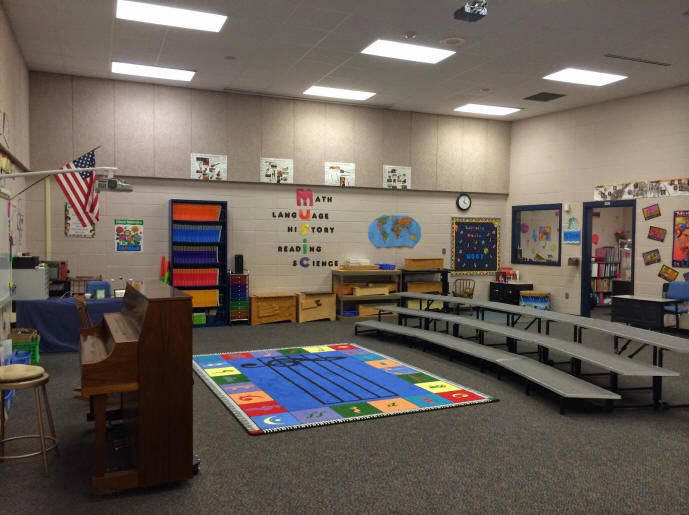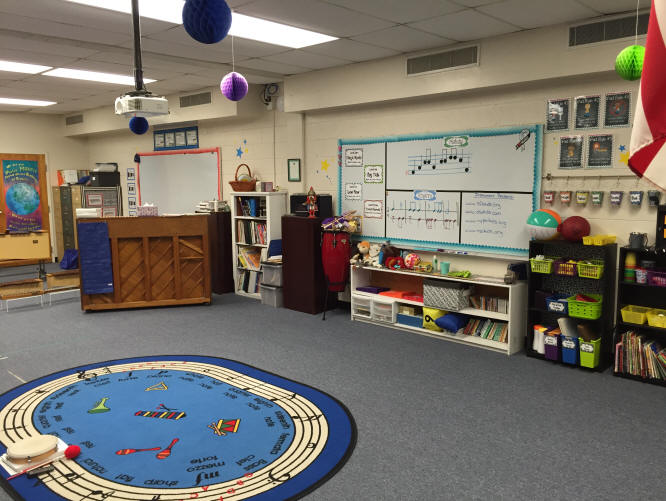MINI-LESSON DME Room Arrangement What should be in your classroom? Here are some options:
Chairs or no chairs - that is the question!
| |
Some Teachers Prefer Chairs because:
| Some Teachers Dislike Chairs because:
|
| General consensus among music teachers (unofficial poll)
Note: teachers remark that if the children are used to chairs, they will complain about the floor; if they are used to the floor, they will complain about the chairs. So, beware of making definitive decisions based upon student reaction! Other room sections if space allows:
| |
| A suitable room is designated for teaching general music. The room is large enough to accommodate the largest group taught and to provide ample space for physical movement. It has appropriate acoustical properties, a quiet environment, good environment, good ventilation, and adequate lighting. It contains storage space for classroom instruments, equipment, and instructional materials. A suitable room is available for teaching instrumental music in every school. The room is large enough to accommodate the largest group taught. It has appropriate acoustical properties, a quiet environment, good ventilation, and adequate lighting. It contains storage space for instruments, equipment, and instructional materials. Sufficient secured storage space is available to store instruments, equipment, and instructional materials. Shelving or lockers are provided for various large and small instruments. In order that every student may have convenient, private access to his or her teacher for consultation and help, office or studio space is provided for every music educator. The music facilities are adjacent to one another, they are acoustically isolated from one another and from the rest of the school, and they are readily accessible to the auditorium stage. All facilities are accessible to persons with disabilities.
| |
| How many of you out there do not have chairs in your classrooms? How do you like it? I wouldn't want it any other way! My kids all start out class sitting on the floor. I made 4 long rows of velcro colored "tape" across my music room floor. The velcro sticky/hook side grips my carpet beautifully. I have a red row, blue, white, (see how patriotic we are?) and green row. Thought about making a floor staff to sit on, but not enough room. 9 students sit on each row behind #'s painted on the velcro, #'s1-9. I take roll with my seating chart and then we're up and moving. After 2 weeks of school, they already know their spot color and #! I have some tables scattered around the perimeter to place instruments on that I'm using that day or other materials, or even a student who needs some time to "Stop and Think" a few minutes out of an activity. But we come back to our "home spots" as needed. I don't worry about writing activities needing tables because I keep a big blue tub of clip boards for such occasions. The kids just go get one as needed or write-on wipe-off boards and a marker. I put instruments in big baskets to use as needed throughout the day if I want to separate them. This is a very versatile and useful space to me. I've done it for 14 years now and have little complaints. The complaints I do get are usually from the 5th grade girls if they've dressed up special that day. I have no problem with letting them sit in a chair on the perimeter of the group if they want that day. Martha in Florida ---------------------------------------------------------------------- I am lucky to have a large, carpeted, former band room (this very small school is lucky to have a music program; and I am grateful to have a job!) So I have three areas: a semi circle of chairs facing the board (small piano in front, between the chairs and the board) the main part of the room has a large staff marked with painters' tape (colored, removable masking tape) and a smaller activity circle also marked with painters' tape in dotted lines. At the opposite end of the room I have tables and chairs for writing/coloring. Oh, and at the front of the room there are three 4' x 4' x 8" plywood boxes that make a stage for performances (there is another piano there) We invite parents to share music activities one day each grading period during the regular music class times. That way all children have an opportunity to perform and not be dependent on parents getting them back for evening performances as we are a remote rural community in the mountains of SW New Mexico. Mary B in NM If you have a small room, I would recommend not using chairs. However, I would have some stacked by the wall for children who absolutely needed to use one. I have a very large room, and I will have to say that I love using chairs. Chairs are arranged in groups of four to make a U-shape. There is a large space in the middle of the room free for movement and playing games. I find that chairs make a great "home base" for children and can help manage behavior. Children need their own space (I realize that it doesn't have to be in a chair) and that visual and physical separation from their neighbors can help manage behavior. I also use the chairs as a teaching tool. Each group of four chairs are identified by a rhythm note. The notes are taped onto the back of their chair. I clap their assigned note to ask questions, assign instruments, line up and most other tasks in the classroom. Students are assigned a new seat every grading period. Students are often engaged in center work in my classroom and may spend five to ten minutes out of the 45 in their seat. We play games and move every lesson. I guess I'm a very structured person, and this seating arrangement works for me. I am fortunate to have the "best of both worlds"- chairs and space. I also think that children appreciate the comfort of a chair. You may have to experiment to see what works best for you. I would definitely get rid of desks or tables, they would get in the way. I hope everyone has a wonderful start to their new school year- chair or chairless! Susan in MN
| |

